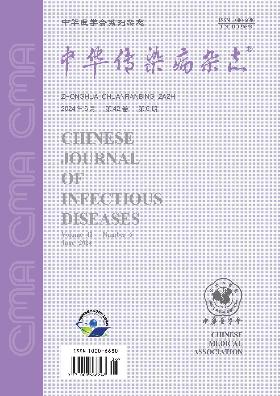Molecular characteristic analysis of neuraminidase genes of avian influenza virus H9N2 in environments in Weining, Guizhou Province during 2015-2017
引用次数: 0
Abstract
Objective To understand the genetic variations of neuraminidase (NA) genes of avian influenza virus H9N2 in Weining, Guizhou Province, and to provide the scientific evidence for the prevention and control of avian influenza virus. Methods Ribonucleic acids (RNA) were extracted and NA genes were amplified and sequenced from 13 randomly selected H9N2 positive samples from the live poultry market (LPM) environments in north of Weining Yi and Hui and Miao autonomous county (Weining), Guizhou Province during 2015 to 2017. Then the homology, genetic evolution, and sites of stalk deletion areas, potential N-glycosylation, receptor binding regions and drug resistance of H9N2 subtype avian influenza viruses were analyzed by a series of bioinformation software. Results Homology analysis revealed that there were 93.0%-100.0% and 92.1%-100.0% similarity among 13 strains H9N2 avian influenza viruses in nucleotide and amino acid of the NA gene, respectively. All strains belonged to DK/HK/Y280/97 sub-lineage, but their genetic sources were complex and diverse. Thirteen strains had a stalk deletion of 3 amino acid residues TEI at positions 63-65 and 3 isolates had mutation QN to QK at positions 39-40. The potential N-glycosylation sites at amino acid residues 86, 146, 200, and 234 of the NA protein of all strains were highly conserved, while other N-glycosylation sites had quantity and site mutations. There were different mutation types at the three sialic acid binding site areas, especially at 399-404 area. All NA protease activity sites and key sites of the 13 strains had no mutations associated with resistance to the neuraminidase inhibitor drugs. Conclusions All 13 strains H9N2 viruses belongs to DK/HK/Y280/97 sub-lineage in Weining, Guizhou Province during 2015-2017, and their genetic sources are complex and diverse. The mutations on sites of stalk areas, potential N-glycosylation and sialic acid binding site areas are presented at different degrees. Hence, enhancing surveillance and controlling H9N2 avian influenza virus is necessary. Key words: Influenza A virus, H9N2 subtype; Neuraminidase gene; Molecular characteristic2015-2017年贵州省威宁市环境中H9N2禽流感病毒神经氨酸酶基因的分子特征分析
目的了解贵州省威宁市H9N2禽流感病毒神经氨酸酶(NA)基因的遗传变异情况,为禽流感病毒防控提供科学依据。方法从2015 - 2017年贵州省威宁彝族、回族苗族自治县北部活禽市场(LPM)环境中随机抽取13份H9N2阳性样本,提取核糖核酸(RNA),扩增NA基因并测序。利用一系列生物信息软件分析H9N2亚型禽流感病毒的同源性、遗传进化、茎秆缺失区、潜在n -糖基化位点、受体结合区位点和耐药性。结果同源性分析显示,13株H9N2禽流感病毒NA基因核苷酸和氨基酸的相似性分别为93.0% ~ 100.0%和92.1% ~ 100.0%。所有菌株均属于DK/HK/Y280/97亚系,但其遗传来源复杂多样。13株在63 ~ 65位缺失3个氨基酸残基TEI, 3株在39 ~ 40位发生QN ~ QK突变。所有菌株NA蛋白的86、146、200和234个氨基酸残基的潜在n -糖基化位点高度保守,而其他n -糖基化位点存在数量和位点突变。在三个唾液酸结合位点区域存在不同的突变类型,特别是在399-404区域。13株菌株的NA蛋白酶活性位点和关键位点均未发生与神经氨酸酶抑制剂耐药相关的突变。结论2015-2017年贵州省威宁地区13株H9N2病毒均属于DK/HK/Y280/97亚系,遗传来源复杂多样。茎区、潜在n -糖基化位点和唾液酸结合位点发生不同程度的突变。因此,加强对H9N2禽流感病毒的监测和控制是必要的。关键词:甲型流感病毒,H9N2亚型;神经氨酸酶基因;分子特征
本文章由计算机程序翻译,如有差异,请以英文原文为准。
求助全文
约1分钟内获得全文
求助全文
来源期刊
自引率
0.00%
发文量
5280
期刊介绍:
The Chinese Journal of Infectious Diseases was founded in February 1983. It is an academic journal on infectious diseases supervised by the China Association for Science and Technology, sponsored by the Chinese Medical Association, and hosted by the Shanghai Medical Association. The journal targets infectious disease physicians as its main readers, taking into account physicians of other interdisciplinary disciplines, and timely reports on leading scientific research results and clinical diagnosis and treatment experience in the field of infectious diseases, as well as basic theoretical research that has a guiding role in the clinical practice of infectious diseases and is closely integrated with the actual clinical practice of infectious diseases. Columns include reviews (including editor-in-chief reviews), expert lectures, consensus and guidelines (including interpretations), monographs, short monographs, academic debates, epidemic news, international dynamics, case reports, reviews, lectures, meeting minutes, etc.

 求助内容:
求助内容: 应助结果提醒方式:
应助结果提醒方式:


